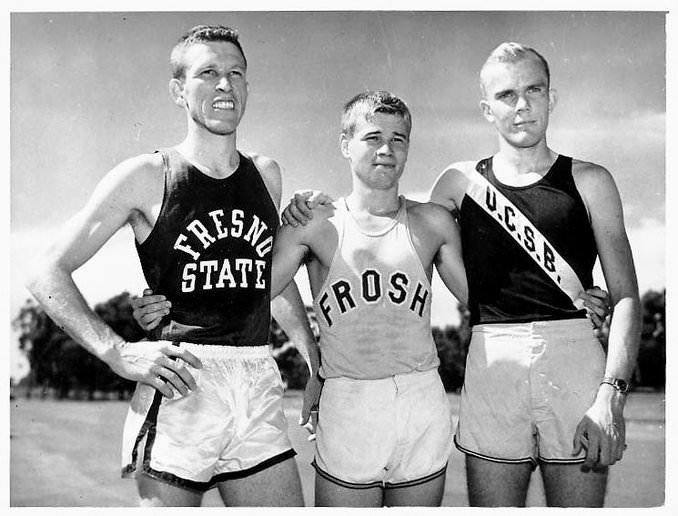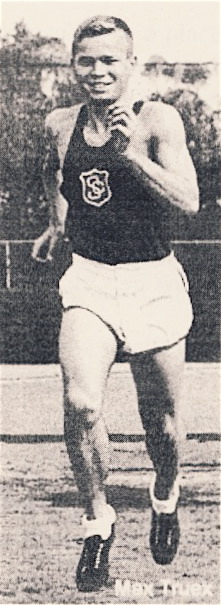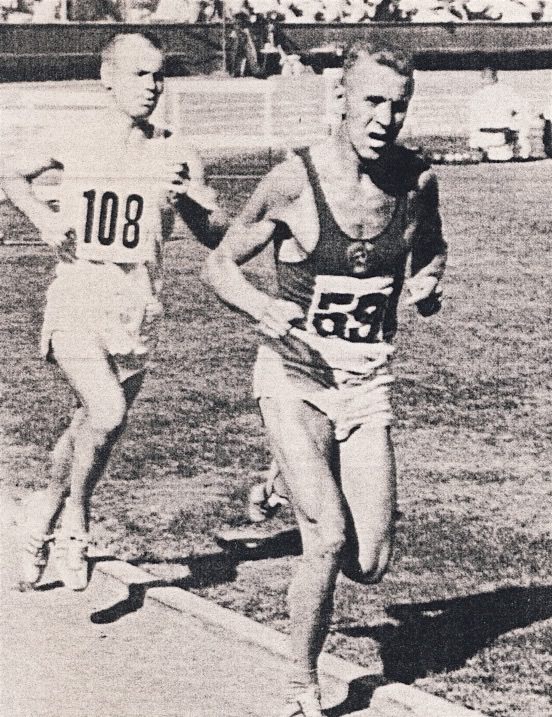Profile: Max Truex
1935-1991
Max Truex was the precursor of the successful modern American tradition in distance track running. His sixth place in the 1960 Olympic 10,000 opened the door for American distance runners in the next Olympics, where they surprised the world by winning golds in both the 5,000 and 10,000 and also a bronze in the 5,000. Before 1960 American distance runners had rarely been competitive on the international scene. Charlie Capozzoli, who won a major European Three Miles in 1952, and Curt Stone, who was sixth in the 1952 Olympic 5,000, were two exceptions. But it was Truex who made the real breakthrough when he became the first American since 1912 to place in the top six of the Olympic 10,000.
After he finished sixth in Rome, Truex was surprised by the reaction: “I was swamped with congratulations. Athletes from all countries came over to say a word. It was amazing and thrilling. Apparently they never thought an American would run that fast.” (Track and Field News, Sept. 1960) In the US at this time, distance running was not popular, and it is difficult to find coverage of Truex’s career in the archives. This lack of interest was noted by the perceptive British correspondent of The Times, Neil Allen, when he referred to Truex’s American Three Miles record in London in 1961 as “another reward for his dedication at an event which holds little interest for his fellow Americans.” (Times, July 31, 1961)
Truex, of course was not the only factor in the emergence of American distance running in the 1960s. The arrival of famed Hungarian coach Mihaly Igloi in California soon had an impact, as did the development of Bill Bowerman as a successful coach in Oregon. Yet another factor was the inclusion of distance races in the epic USA v. USSR series (1958-1965). This Cold-War series exposed the public and the media to the drama of these events, especially the event-filled 1959 10,000 in Philadelphia, in which Truex competed with great courage. Nevertheless, Max Truex should be remembered as the first American who showed many times that it was possible to compete internationally in distance events. He was the first of a great tradition that stretches through Mills and Schul to Shorter, Prefontaine and Rodgers, to Salazar and Kennedy, to Solinsky and Rupp.
Early Career
| Truex (left) running cross country for USC. |
Truex began running at age 13. At 17 his best Mile time was 4:32.1. But at age 18 in 1954, he improved significantly to run the fastest-ever high-school Mile time with 4:20.4. Later that year he reduced his PB to 4:18.5 when he competed in the American Senior Championships (AAU). He then moved on to the University of Southern California (USC) to train under Coach Jim Slosson. He quickly showed promise with a sixth in the 1954 NCAA Cross Country Championships.
In his first track season at USC in 1955, Truex improved his Mile to 4:10.6 and ran 9:15.5 for Two Miles. But perhaps his most significant race of the season was the AAU 5,000 at altitude. For much of the race he was up with the leaders, and at nine laps he was in second place. Then, overcome by the effects of altitude, Truex had to stop. Still, he was able to start running again and managed to finish the race in 6th place, running the last lap in 86.6 and then losing consciousness. This race demonstrated the ferocious competitiveness of Truex. There were to be other occasions when he ran himself to a standstill. In fact, in the NCAA cross-country championships that fall, he again ran himself to exhaustion in trying to win the title: he was third at 3 1/2 miles and with 880 to go he was within 10 seconds of second place, but then he hit the wall and finished ninth, losing 26 seconds on the leaders.
 |
| Truex with Len Thornton (left) andGordon McClenathen (right) in 1954. |
According to his younger brother Dan, Max Truex was often asked about his determination and competitive drive. In reply, he would often refer back to a horrendous automobile accident involving the three Truex brothers, Gene (16), Max (12) and Don (11). They were hit by a dumptruck, and Gene, who was driving, lost his life. Much later, Max would talk of the tough times afterwards when he had to assume the role of eldest brother. Don saw a change in his brother after the accident: “It was that event—he was trying to prove something. I never did quite understand it.” Maybe it wasn’t a coincidence, especially since Gene had been a high-school miler, that the following year Max started competing in races. Don often noticed how driven his brother became in his running. He recalls seeing Max from the rooftop of a foundry where he was working, watching him run a cross-country loop round the local fairground: “Max had run that loop so much he had worn down all the grass.”
Melbourne Olympics
Despite his dedicated training regime, at the end of 1955 Truex seemed a long way from making the American 1956 Olympic team. However, in the spring 1956 track season he showed amazing stamina for 20-year-old, running the sixth-fastest-ever American time for 5,000 with 14:31.4. And in the summer, he actually qualified for the Olympics in the trials, with a win in the 10,000 (30:52) and a third in the 5,000 (14:30.8) behind Dellinger and Stone. His form for the December Olympics looked good when in October he ran two 5,000 races in 14:32 and 14:22.8 (an American record).
Sadly, Truex then suffered a major setback. Before the Games, he strained a muscle in his right hip, making him a doubtful starter because any running was extremely painful. Nevertheless, he decided to run in the 10,000. In constant discomfort, he was lapped by the leaders on the 11th lap when running one from last. At this point he felt it was sensible to drop out. Track & Field News reported that at this time his left leg was 3/4 inch shorter than his right!
Such a setback did not stop Max Truex. He was back competing three months later, first running 8:57 for Two Miles and then winning races in 8:55 and 8:57.5. In May he ran a PB Three Miles (13:35.7) and finished off the season with a second place in the AAU meet, running second to Macy with 14:03.0. His good form continued into the 1957 cross-country season as he posted wins in the Pacific Coast race and in the NCAA championship, where he beat Macy.
From USC to USAF
Truex began the 1958 season with an 8:54.8 Two Miles and improved to 8:50.7, his season’s best. But he couldn’t quite find the form of 1956 and 1957. He was only third in the NCAA Two Miles, 14 seconds behind the winner Henderson. Then in the AAU Three Miles he was a disappointing fourth behind Henderson, Tabori and Dellinger (13:47.7). The only race in which he excelled was the 5,000 in the initial USA v USSR meet. He was teamed with Bill Dellinger to tackle two fine Russian runners in Bolotnikov and Parnaviki. The Russians, always at the forefront of distance running, were considered a shoe-in for maximum points. However, at the bell, Truex and Dellinger were still with the leaders. The last lap featured a great battle between Dellinger and Parnakivi, who both finished in the same time of 14:28.4, with the Russian getting the win. Truex finished less than four seconds behind them and earned a valuable point ahead of Bolotnikov.
| Truex (left) battles the elements. |
Another change in Truex’s life was the start of his four years’ military service in the USAF. With such a promising competitive record he was encouraged by the military to continue his running, and he was given a lot of privileges that enabled him to train and compete at the top level. He was based at Oxnard AFB in California, but he and some other runners were still able to maintain an apartment in Los Angeles and spend periods of 3-4 days there to join the best training groups. According to his brother Don, Max had demanding work at the base, where he was in charge of the theatre and the swimming pool. Later someone told Max that in the first 600 days of his military service he had 350 days off duty. His 1959 season produced the same level of results: there were no real improvements in his times. It was a year of change for him, as he graduated at the end of 1958 and was thus no longer coached by Jim Slosson. It was at this time that he began to train under Hungarian coach Mihaly Igloi.
Despite the leveling out of his times in 1959, he did have a more successful competitive record, winning three big races: Two Miles in the Coliseum Relays (8:50.7); 5,000 in the Compton Relays (beating Tabori with 14:05.8); and the AAU 10,000 (31:24).
His strong competitive spirit was evident again in the 10,000 of the second USA v USSR meet. This race was held in Philadelphia summer heat; three of the four runners collapsed from heat exhaustion. Truex was partnered by Bob Soth against Parnaviki and Desyatchikov. Truex was dropped before the two-mile mark and was almost half a minute behind at 5,000. Soth, on the other hand, was running the race of his life and actually led for four laps before the halfway point. After this Desyatchikov went out on his own while Soth and Parnakivi fought it out for second. After lapping Truex, Soth started to run awkwardly and soon after Truex passed him he collapsed. Truex then realized that Parnakivi could be caught and made a huge effort to pass him before the tape. Bizarrely, Truex was denied second place when the Russians claimed he had previously been lapped by Parnakivi. With Parnakivi lying on the ground, he was forced to run an extra lap to earn the third-place point before collapsing himself.
Rome Olympics
At this stage in his career, the 24-year-old Truex appeared to have reached his peak. Almost every American runner stopped serious competition after leaving university. Truex however did not quit, having been able to continue serious running while in the Air Force. As well, he still looked to some of the best coaches for help. Coach Mihaly Igloi worked on his carriage and breathing. As well, he was in contact with Bill Bowerman, the Oregon coach.
 |
With the Rome Olympics approaching, Truex had a low-key early track season. Then in the AAU and Olympic Trials he made the Olympic team with a third place (first American) in the 10,000 (30:16.3 PB) behind Lawrence of Australia and Kyle of Canada. Four years earlier he had won the trials with a 30:52.
With a PB over 30:00, his chances in Rome did not look good. However, in a pre-Olympic race in Switzerland he won a 10,000 race in 29:35.8, a PB and a US record. Clearly he was rounding into form at the right time. His plan in the Olympic 10,000 was to run at an even pace. He did this almost perfectly: 2:50.6, 2:54.1, 2:54.3, 2:54.0, 2:56.5, (14:26.5) 2:54.4, 2:54.9, 2:54.7, 2:56.8, 2:42. 9 (28:50.2). With a last lap of 60, he ran his last K eleven seconds faster than his average. Despite the heat in Rome, he had shattered his PB by 45.6 seconds and was never to run as fast again. It was clearly a very disciplined run under the exhilarating pressure of Olympic competition. And his achievement was immediately recognized by his fellow competitors. On his part, Truex expressed his gratitude for the coaching and advice from Igloi and Bowerman.
Truex made use of his good form in Europe after the Games and confirmed he was a world-class distance runner. He ran well behind Halberg and Dellinger in a Two Miles (8:44.6) and then ran a 13:38 Three Miles behind Salvat and Tulloh with all three runners finishing within 0.4 of a second.
Late Career
Although his 1961 season showed promise, Truex could not have been happy with the results. He was a disappointed second to Tabori in the AAU Three Miles (13:52.4). He had led for seven laps and then slowed right down. This set up the race for the fast finishers. Tabori jumped Truex in the last lap for a comfortable victory, and Clohessy almost got second. “I should have pushed it,” Truex told Track & Field News.
 |
| Trailing Bolotnikov in vain |
Truex did better in Moscow, where he placed second in the USA v USSR 5,000 (14:05.4). He gave Olympic 10,000 champ Bolotnikov a good race, but he had no answer when the Russian made his move at the bell. Staying over in Europe afterwards, he next ran a fine Three Miles in London. Although finishing third behind Pirie and Tulloh, he nevertheless broke the US record with 13:21.0, which was to remain his career best. He followed this fine run with an 8:47.1 seasonal-best Two Miles and a 10,000 victory in a match against Poland.
For a while it looked like he was in for a good year in 1962, with an 8:50.3 Two Miles, and an American record 5,000 of 13:49.6 in the Compton Relays. In the latter race, he impressed with a fine last lap to finish ahead of Olympic champ Halberg, but Canadian Bruce Kidd was an easy winner. Truex also looked good in the AAU Three Miles despite losing to Halberg (13:30.6 to 13:32.8). But then he disappointed in the USA v USSR 10,000, despite giving it his all. He battled it out with Bolotnikov yet again and held on to the Russian until the last four laps. But then he fell back and was passed by Ivanov, the second Russian. After the race it was discovered that he had run with a huge blood blister on the ball of his foot. Such pain would have stopped many runners, but not Truex.
Retirement
Sadly it was this blister that finally ended Truex’s long career. Don Truex recalls the blister: “After the race we were in the training room, and a physician there got out his scalpel and cut off all of that skin. You need to keep that skin covering it until the skin underneath matures enough. The outer skin would then slough off. But to cut off that outer skin—oh, you’ve got a big problem.” (Personal interview, October 2011) The “big problem” went on for over a year. Don Truex remembers his brother being treated by a podiatrist and dealing with a fungus in the wound.
| Truex was popular at indoor meets. |
At 27, Truex gave it one more try in 1963 despite the continuing problem with his foot. Not surprisingly the early results were disappointing. He was only fifth in a Two Miles at Compton (8:54.9) and third in a slow Three Miles in June (14:08.8). His last recorded race was a 5,000; he placed third in 14:17.8. Truex did not compete in the AAU that year, nor did he compete in the USA v USSR meet. With the end of his military service and his planned enrolment in law school imminent, Max Truex retired from competitive running.
He graduated in 1966 and became a prominent trial lawyer in Los Angeles County, specializing in real-estate litigation. Some ten years later Truex was diagnosed with Parkinson’s disease. He fought the disease with the determination he had shown as a runner, even undergoing an unorthodox operation in China for a fetal brain transplant. But at age 55, after a 15-year struggle with the disease, he died.
Although Max Truex will probably be remembered most for his ground-breaking sixth place in the 1960 Olympic 10,000, his legacy is much richer. He will also be remembered because his name appears at least ten times in the American records list. And there’s more. He not only showed that Americans could compete at the longer distances on the track, but he also raced with such courage and determination as had rarely been seen on a running track. If Truex was in a race, you knew that it would be exciting. He enjoyed racing; spectators enjoyed watching him race. The Mighty Mite, as he was affectionately called, was especially popular on the Eastern indoor circuit, where spectators were up close to the track and thus more involved in the competition.
The source of his determination and courage will never be fully explained, but there is little doubt that some of it was in response to the trauma from the dreadful auto accident that took the life of his big brother Gene. For ten years, Max Truex trained and competed with a passion rarely seen in the USA before. All the great American distance runners that followed him have benefited from his example. 
7 Comments